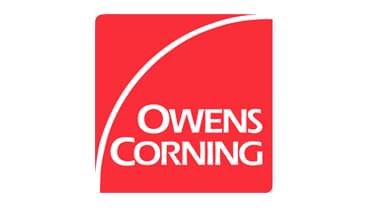Owens Corning Fiberglas Corporation
Owens Corning manufactured asbestos products from the 1950s through 1972. Asbestos litigation caused the company to file for bankruptcy in 2000. A trust fund was established to compensate victims. It contains approximately $1.07 billion.

Owens Corning’s History with Asbestos
From the 1950s to 1972, Owens Corning added the toxic mineral asbestos to its ceiling tiles, mastic, cement and insulation for pipes, ducts, equipment and cold storage systems. At the time, asbestos was widely used because of its natural resistance to heat.
In 1997, Owens Corning acquired Fibreboard Corporation, which made a variety of asbestos-containing insulation and construction products. The acquisition made Owens Corning liable for injuries caused by Fibreboard’s asbestos products.
Owens Corning began facing asbestos lawsuits in the late 1970s. Over the next three decades, it was named in hundreds of thousands of asbestos lawsuits. By 2000, it had settled with 440,000 people who claimed Owens Corning’s products caused them to develop asbestos-related illnesses such as mesothelioma.
Development of Asbestos Trust
Owens Corning tried several legal and financial maneuvers in an attempt to avoid bankruptcy. In 1998, it combined 176,000 asbestos claims into the National Settlement Program and attempted to settle them for $1.2 billion.
However, the program quickly grew to include 237,000 claims. In 2000, approximately 10,000 claims were filed in the third quarter alone. Owens Corning announced it could not afford the debt and filed for Chapter 11 bankruptcy in October 2000, according to The Washington Post.
Part of the company’s reorganization plan involved the creation of the Owens Corning / Fibreboard Asbestos Personal Injury Trust in 2006. The trust was funded with about $5 billion to compensate victims of both Owens Corning and Fibreboard Corporation. By 2008, the trust had paid out $1.4 billion in asbestos claims.
In May 2011, Owens Corning sold 7,000,000 shares of stock and all proceeds went to fund the trust.
The current payment percentages are 7.8% for Owens Corning claims and 6.7% for Fibreboard claims.
In September 2021, the trust updated signature policies for exposure evidence and release forms to allow claimants to use electronic signatures along with one witness signature in lieu of notarization.

Gain access to trust funds, grants and other forms of compensation for you or your loved ones.
Get Help NowAsbestos Litigation Involving Owens Corning
The first asbestos-related claims against Owens Corning emerged in 1978 when two shipyard workers with asbestosis chose to file a class action lawsuit on behalf of 5,000 other workers.
The lawsuit, filed against Owens Corning and 14 other manufacturers of asbestos-containing products, alleged the companies knew about the dangers of asbestos as early as 1938, but failed to properly warn workers about the hazards of asbestos exposure.
By 1990, Owens Corning was the defendant in roughly 84,500 asbestos-related lawsuits. By the time of its bankruptcy, Owens Corning had been named in 243,000 asbestos-related claims.
In one standout case in 1997, a Florida jury awarded Deward Ballard $31 million in punitive damages and $1.8 million in compensatory damages after he developed mesothelioma cancer from working with Owens Corning products. The court determined that Owens Corning had concealed information concerning asbestos hazards for more than 30 years.
Owens Corning Asbestos Products & Workers at Risk
Workers in the construction industry, especially insulators, were at risk of working with Owens Corning’s asbestos products.
Owens Corning products that contained asbestos included:
- Kaylo Heat Insulating Block
- Kaylo Pipe Insulation
- Kaylo Duct Insulation
- Kaylo Equipment Insulation
- Kaylo Cold Storage Systems
- Kaylo Insulating Roof Tile
- Ceiling Tile
- One Cote Cement
- Insulating Cement
- Finishing Cement
- Type II Mastic
- Ready Mix
Insulators who worked in homes, commercial buildings and industrial settings may have handled Owens Corning’s asbestos insulation.
The company’s pipe insulation was also commonly used on U.S. Navy ships. As a result, shipyard workers and Navy crew members were at risk of exposure to asbestos-containing pipe insulation.
Other occupations at risk of exposure to Owens Corning’s asbestos products include roofers, cement workers, carpenters and painters.
Owens Corning History
Owens Corning initially got its start as Corning Glass, a company that experimented with glass fiber.
In 1935, Corning Glass approached Owens-Illinois with a proposal to join forces, and by 1938, the Owens-Corning Fiberglas Corporation was announced. The company worked under this name until 1996, when it was shortened to Owens Corning to reflect a growth in business.
Owens Corning was the first to manufacture fiberglass insulation, and it quickly became the most popular form of home insulation. Owens Corning is now the world’s largest fiberglass manufacturer.
The company went public in 1952, and from the 1960s through the 1980s, Owens Corning expanded into new markets.
In 1986, the company dealt with a hostile takeover bid by taking on $2.5 billion in debt, a move from which Owens Corning never recovered. An economic slowdown in 1989 undercut the company’s profits in the construction industry. Asbestos litigation added to the company’s financial woes.
The company’s decline continued throughout the 1990s. A few years after the acquisition of Fibreboard Corporation, Owens Corning filed for bankruptcy and created a personal injury trust to handle asbestos claims filed against both companies.
In 2017, Owens Corning acquired Pittsburgh Corning Corp. for $560 million. The Pittsburgh-based glass manufacturer emerged from Chapter 11 bankruptcy protection in 2016. It was previously owned by the Pittsburgh Corning Asbestos Personal Injury Settlement Trust as part of a multi-billion-dollar settlement of asbestos claims.
Recommended Reading


